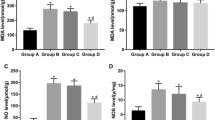Summary
Testicular torsion patients have significant fertility problems, which may be due to bilateral testicular disease. This study was designed to define expression of spermatozoal alloantigens and autoantigens on rat spermatozoa by immunization experiments and highly sensitive immunological techniques, and then determine whether or not experimental torsion results in autoimmunization. Sperm protein alloimmunization and autoimmunization experiments were first performed. Later, experimental torsions were applied for periods from 1 h to permanent torsion and also torsion followed by orchidectomy. Sera from these animals were then tested and compared to controls for evidence of immunological activation. Immunoblotting and dot ELISA tests demonstrated spermatozoal autoantigens following intradermal immunization and that experimental torsion is followed by a rising titre of sperm protein autoantibodies. The possible consequences of these findings are discussed.
Similar content being viewed by others
References
Bartsch G, Frank S, Marberger H, Mikuz G (1980) Testicular torsion: late results with special regard to fertility and endocrine function. J Urol 124:375–8
Brown PC, Glynn LE, Holborew EJ (1967) The dual necessity for delayed hypersensitivity and circulating antibody in the pathogenesis of experimental allergic orchitis in guinea-pigs. Immunology 13:307
Chakraborty J, Hikim AP, Jhunjhunwala JS (1985) Quantitative evaluation of testicular biopsies from men with unilateral torsion of the spermatic cord. Urology XXV (2):145–50
Chakraborty J, Jhunjhunwala J, Nelson L, Young M (1980) Effects of unilateral torsion of the spermatic cord on the contralateral testis in human and guinea-pig. Arch Androl 4:95–108
Consentino MJ, Nishida M, Rabinowitz R, Cockett ATK (1985) Histological changes occurring in the contralateral testis of prepubertal rats subjected to various durations of unilateral spermatic cord torsion. J Urol 133:906–11
Cvetkov D, Karapandov M (1981) Torsion of the testis and fertility disturbances. Akus I Ginekol XX (6):471–5
Fainboim L, Sztein MB, Serrate S, Mancine R (1978) Transfer of experimental allergic orchitis with immune RNA. Clin Exp Immunol 34:92–99
Fraser J, Slater N, Tate C, Smart JG (1985) Testicular torsion does not cause autoimmunization in man. Br J Surg 72:237–8
Freund J, Lipton MM, Thompson GE (1953) Aspermatogenesis in the guinea-pig induced by testicular tissue and adjuvants. J Exp Med 97:711–30
Graziotti P, Lembo A, Zanchetta R, Foresta C, Bassi P, Scrufari P, Mastrogiacoma J (1981) Fertilitia ésterilitia dopo torsione del furscido spermatico. Urologia 48 (3) 700–7
Jones R, Pholpramool C, Setchell BP, Brown CR (1981) Labelling of membrane glycoproteins on rat spermatazoa collected from different regions of the epididymis. Biochem J 200:457–60
Katsch S (1960) Localisation and identification of antispermatogenic factor in guinea-pig testicles. Int Arch Allergy 16:241–75
Krarup T (1978) The testis after torsion. Br J Urol 50:43–56
Ludwig G, Haselberger J, Munzenmaier R (1979) Early changes of testicular tissue following experimental torsion of the spermatic cord. Urologe Auog A 18:294–7
Mastrogiacomo I, Zanchetta R, Graziotti P, Betterle C, Scrufari P, Lembo A (1981) Immunological and clinical study in patients after spermatic cord torsion. Andrologia 14:25–30
Mauss J, Hackstedt G (1972) The effect of unilateral orchidectomy and unilateral cryptorchidism on sperm output in the rat. J Reprod Fert 30:289–92
Nagler HM, Deitch AD, deVere White R (1984) Testicular torsion: Temporal considerations. Fertil Steril 42:257
Nagler HM, deVere White R (1982) The effect of testicular torsion on the contralateral testis. J Urol 128:1343–8
Setchell BP, Waites GMH (1975) The Blood-testis barrier. In: Hamilton DW and Greep R (eds) Handbook of physiology. S American Physiological Society, Washington DC
Soderstrom K, Andersson LC (1981) Identification of the autoantigen expressing cells in the rat testis. Exp Mol Path 35:332–7
Thomas WEG, Cooper MJ, Crane G, Lee G, Williamson RCN (1983) Testicular malfunction after torsion. Br J Surg 70:690
Thomas WEG, Williamson RCN (1983) Diagnosis and outcome of testicular torsion. Br J Surg 70:213–16
Towbin H, Gordon J (1984) Immunoblotting and dot immunoblotting: current status and outlook. J Immunol Methods 72:313–40
Williamson RCN, Thomas WEG (1984) Sympathetic orchidopathia Ann R Coll Surg Eng 66:264–6
York JP, Drago JR (1985) Torsion and the contralateral testicle. J Urol 133:294–7
Zanchetta R, Mastogiacomo I, Craziotti P, Foresta C, Betterle C (1984) Autoantibodies against leydig cells in patients after spermatic cord torsion. Clin Exp Immunol 55:49–47
Author information
Authors and Affiliations
Rights and permissions
About this article
Cite this article
Ryan, P.C., Fitzpatrick, J.M. Experimental testicular torsion: Do spermatozoal autoantigens cause immunological activation?. World J Urol 4, 92–99 (1986). https://doi.org/10.1007/BF00326401
Issue Date:
DOI: https://doi.org/10.1007/BF00326401




